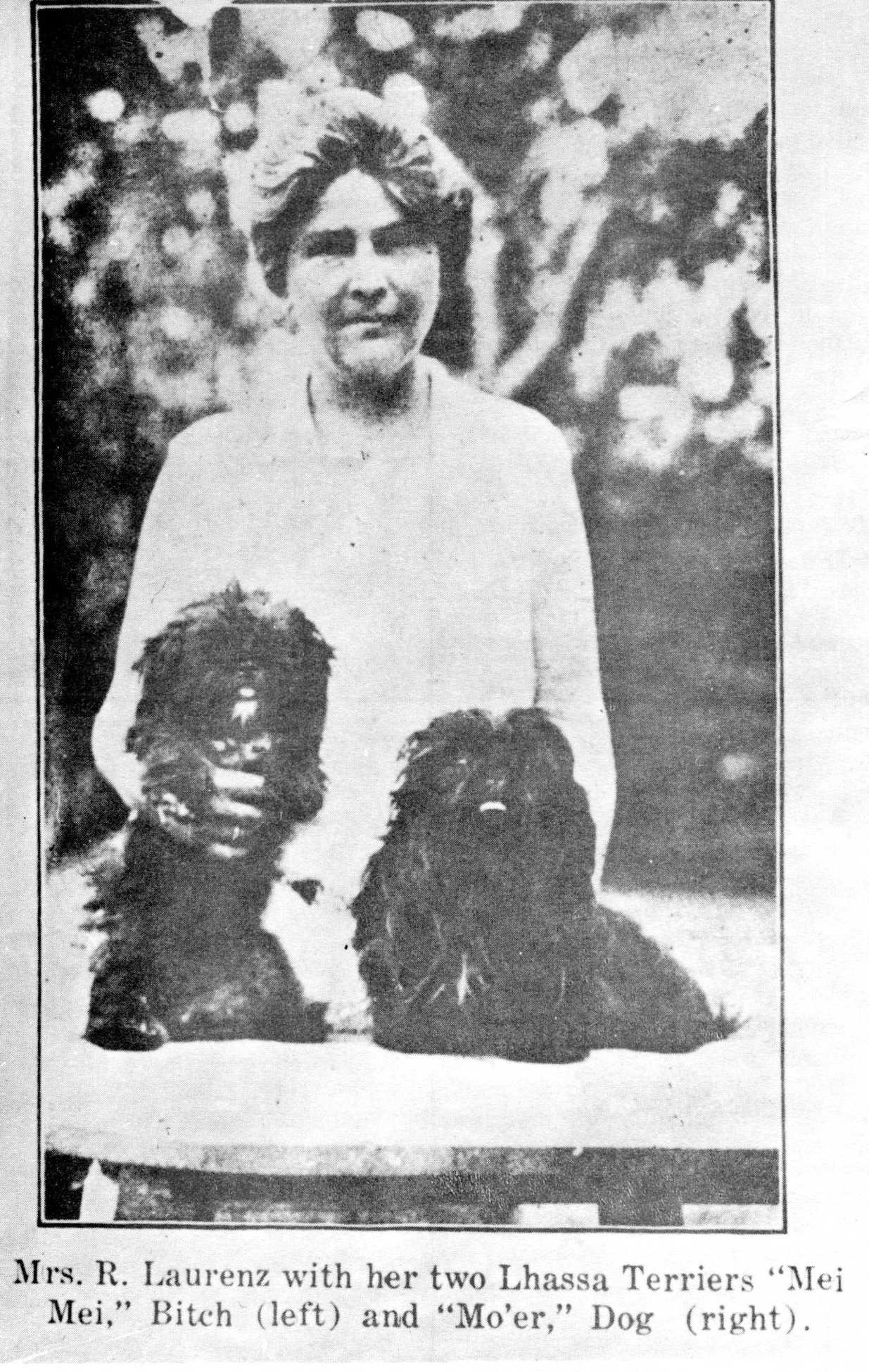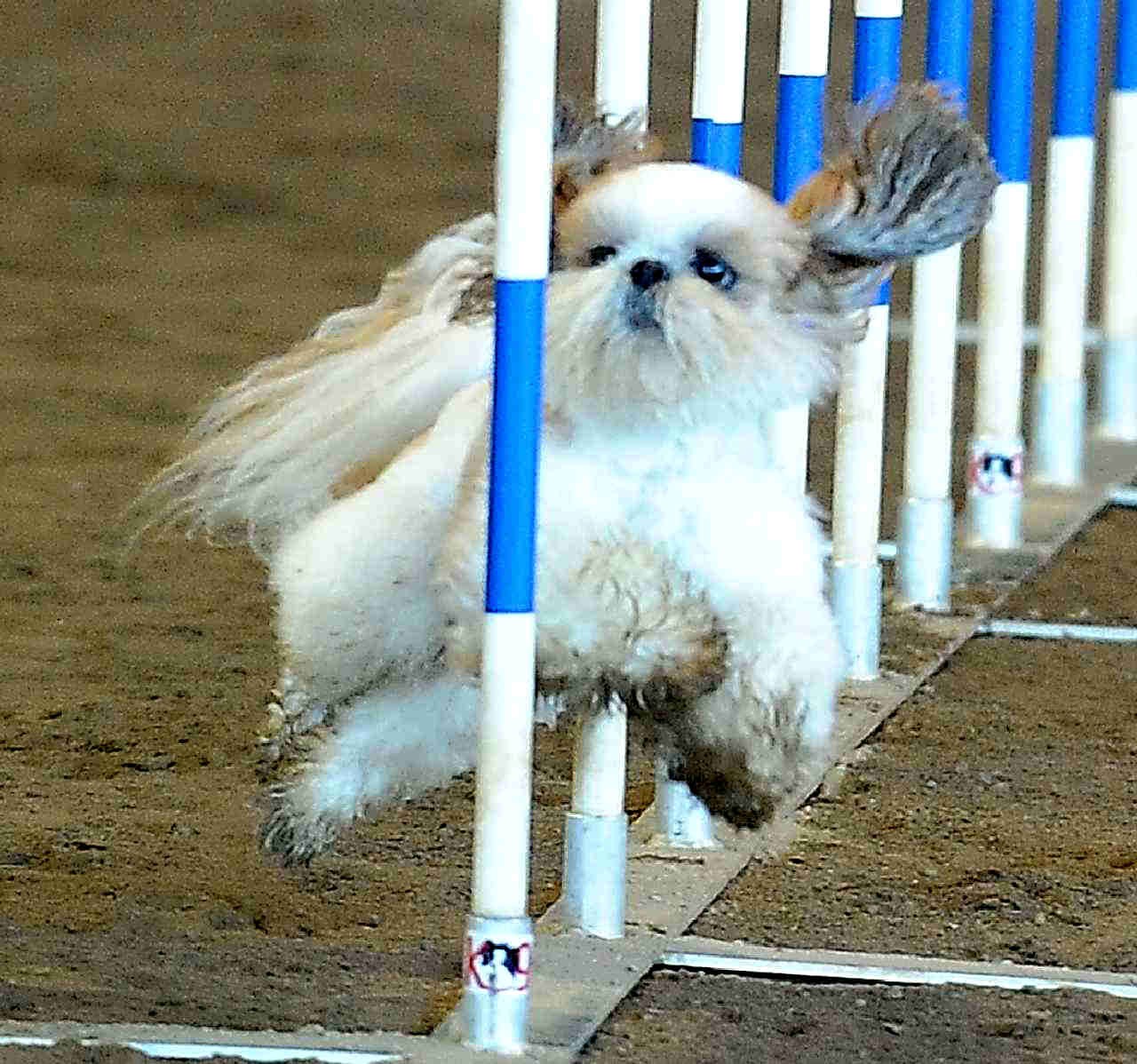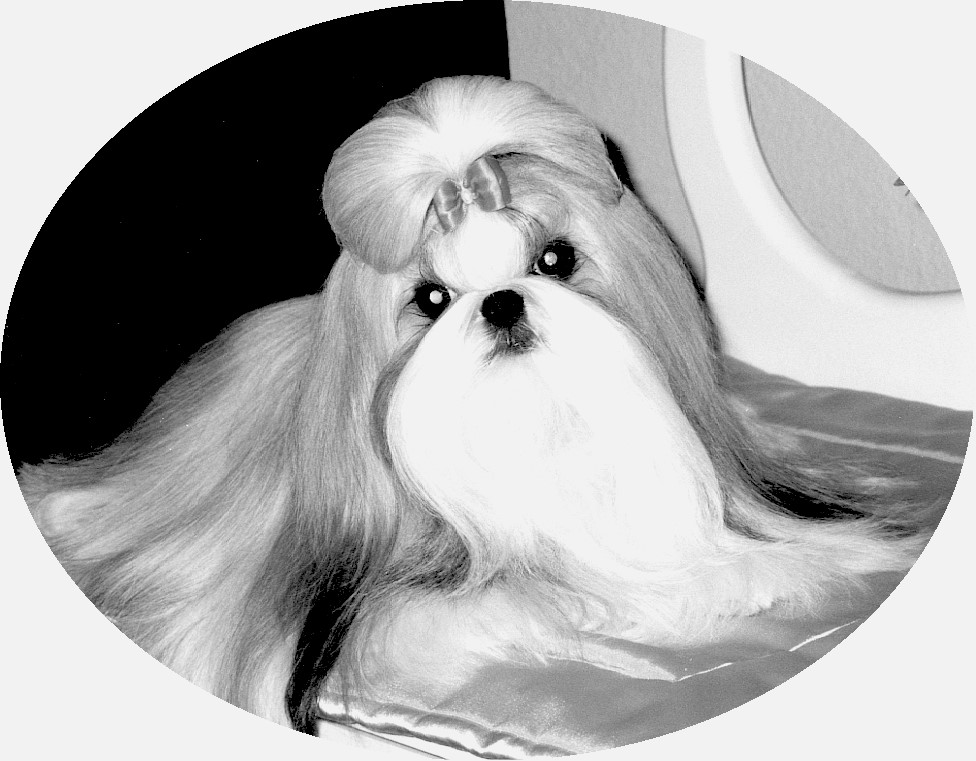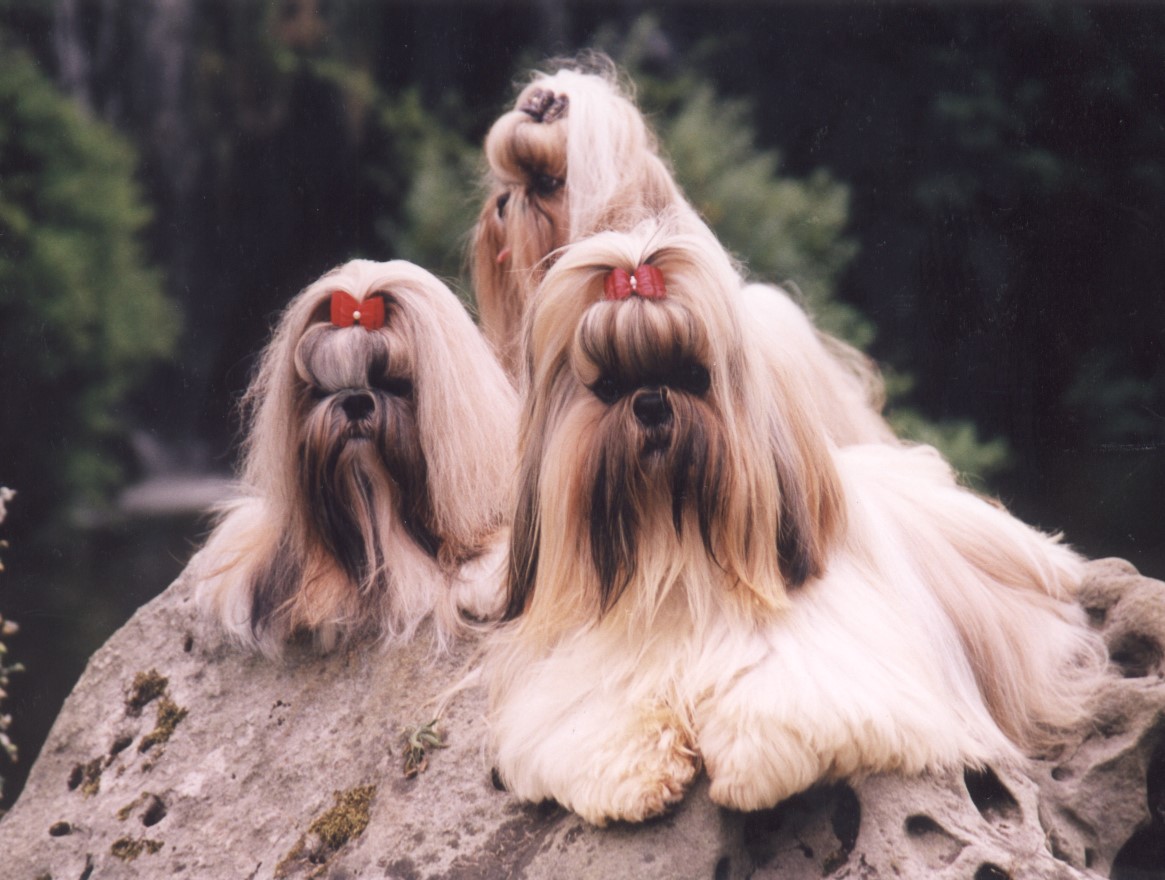A BRIEF HISTORY OF THE SHIH TZU
By Madonna Holko

Man’s affinity for dogs and vice versa over thousands of years is well-documented. While we have a tendency to believe that early dogs were quite large and fearsome, after all they did have to fight for a living, Victor Joris, in his book “The Complete Shih Tzu”, has a photo of a statue from an eighth century Chinese grave showing a tall woman with a very small, Chihuahua-size dog, albeit with a flat face, at her feet; so, we know toy dogs are not a modern invention. That such small dogs were valued is also proven by reports of them being taken as spoils of war or being exchanged between rulers as special gifts. We are told that once Buddhism reached China, dogs became especially valuable because they were thought to be able to transform into lions for the Buddha to ride upon. Therefore, efforts were made to create dogs that looked like their interpretation of lions. One has only to look at Foo dogs to realize how fantastic their imaginations were!
 The custom of Chinese emperors giving treasured dogs as gifts to foreign rulers continued throughout history, with early Pugs going to Holland in the eighteenth century and Pekingese to Queen Victoria in the nineteenth. It is interesting to note, however, that no Shih Tzu ever left China until the twentieth century and not until after the Chinese no longer had an empire with an Empress to protect them. There were frequent descriptions of the dogs in the Imperial Palace, particularly under this last Empress, which included “shag dogs” as well as the familiar pugs and Pekingese so we know they were there. Why they never got out of the country is a question without an answer.
The custom of Chinese emperors giving treasured dogs as gifts to foreign rulers continued throughout history, with early Pugs going to Holland in the eighteenth century and Pekingese to Queen Victoria in the nineteenth. It is interesting to note, however, that no Shih Tzu ever left China until the twentieth century and not until after the Chinese no longer had an empire with an Empress to protect them. There were frequent descriptions of the dogs in the Imperial Palace, particularly under this last Empress, which included “shag dogs” as well as the familiar pugs and Pekingese so we know they were there. Why they never got out of the country is a question without an answer.
During the years of the empress’ life, she was very particular about the breeding of her dogs and thus very judgmental. Those not measuring up to her standard were lucky to find homes with minor royalty or influential people outside the palace. After her death, while China was in turmoil, foreign diplomats were able to acquire dogs that were said to have come from the palace where they had been carefully bred and cared for by eunuchs for many years, but only one that was actually born in the palace made it to the west. The long-haired dogs had many names at this time of which “Lhasa Terrier” or “Apso” seemed to be more common. These names point to the fact that they were considered to have been imported from Tibet instead of having originated in China but considering the efforts of eunuchs at breeding to please the empress, one cannot consider them to have been purebred in any sense of the word. There was a Peking Kennel Club in the late thirties which actually held dog shows where the long-haired dogs were entered. However, the judge complained that the lack of uniformity among the dogs, albeit they all had short muzzles, long hair and tails carried high over the back, made judging them quite difficult if not impossible. We owe the appearance of the Shih Tzu of today to the few Europeans who managed to obtain what they considered good specimens of the shaggy dogs and successfully bring them back to Europe.

Above photo taken in China in 1930 Once the dogs got to Scandinavia and England, efforts were made to draw up an official standard for the breed and to come up with a name more befitting to their heritage. The English settled on “Shih Tzu”, the Chinese word for lion, and Scandinavia followed suit. Unfortunately, early Shih Tzu who were imported into the United States were often referred to as Apso and so were registered as Lhasa Apso, which led to the Shih Tzu languishing many years in the Miscellaneous class because of the confusion, as well as the possibility that some of today’s Lhasa Apsos have Shih Tzu ancestors and vice versa.

These early breeders were faced with a major undertaking, stabilizing a type of dog that they really were not very familiar with. Although there were a few people still living who had seen the dogs while in the imperial palace, their descriptions were not specific enough to be a blueprint. Being in agreement that the dogs were small, short-faced and long-haired helped, but the fact that the early exports out of China were sometimes overshot in bite, high in the rear, and varying greatly in size meant a lot of work had to be done to standardize the breed. Size has always been a point of disagreement. In the early years, the Scandinavian Shih Tzu were noticeably smaller than those in England, probably due to the specimens each importer brought home from China and the twenty years of inbreeding into those lines. Although they both agreed upon a weight of nine to sixteen pounds, the English breeders wanted a more substantial dog, one with good bone and body, while the Scandinavians wanted a more elegant dog befitting a royal palace. Continual inbreeding from a very small pool of genes resulted in the Scandinavian dogs not only being smaller but, according to an English breeder-historian, also gave them a more retiring disposition. World War II interrupted the development of the breed but once it was over, both groups put great effort into reaching a concurrence of opinion on what the Shih Tzu should look like, importing from each other to broaden the gene pool. The one point never in question was that Shih Tzu were extremely devoted to humans, loving all they met, showing their self-confidence by holding their heads high in balance with an equally high arched tail.
In the early fifties, an English Pekingese breeder who acquired some Shih Tzu decided they were in need of help in regard to body, bone, and pigment so she bred one of her Shih Tzu to one of her Pekingese with the blessing of the English Kennel Club but definitely without the blessing of the other Shih Tzu breeders. The uproar that followed lasted for quite some time but the fact that many of these Shih Tzu breeders eventually incorporated dogs descended from this cross into their breeding programs seems to prove that it was indeed necessary. Considering that there undoubtedly are Pekingese somewhere in the dark recesses of Shih Tzu history, it wasn’t really that much of an outcross. Some European breeders who opposed this cross went to great lengths to maintain a line of Shih Tzu without it; today, it would take a very determined pedigree research to find if any are left.
The issue of size continued well into the sixties. Since Shih Tzu coming to the United States were from both England and the continent, American breeders soon began mixing bloodlines to get what they thought was the perfect Shih Tzu. With the exploding popularity of the breed once AKC granted recognition in 1969, producing puppies to satisfy the demand meant even more crossing of lines with little regard to whether or not they were English or Scandinavian. Nowadays it would be hard to find an ‘English” or a “Scandinavian” style Shih Tzu, although a Shih Tzu that is low on leg, a little long in the back, and with a big head is often referred to as “old-fashioned.” And, there are those today who insist the breed should be quite small, entitling them “Imperial” in an effort to make it seem that that was the size they were in China. However, anyone who has been breeding Shih Tzu for any length of time knows you cannot reliably produce Shih Tzu who mature at less than eight pounds and when trying are usually rewarded with unhealthy, disfigured dogs no one would expect to find in a palace.

If beauty is in the eyes of the beholder size certainly follows. Without picking up a dog it is impossible to determine if it really is a small, sturdy dog as called for in the Standard, or a lightweight bit of fluff. One must remember that being small does not always mean lightweight. Many Shih Tzu breeders and judges today would do well to remember the Pug “multum in parvo” description when it comes to our breed.

From Europe Shih Tzu spread around the world and today it is difficult to find a country without them. While they appear in both the Toy group and the Non-Sporting group, their ancestors did come from inhospitable lands where it was necessary to be sturdy and adaptable. Being small also made it necessary to be very friendly to the larger humans who could protect them and being treasured should mean being self-confident. Having reviewed many histories of the breed to remind myself of the facts I have realized that the Scandinavian ethos has won out. American Shih Tzu of today are rarely the rugged, outgoing dogs the English preferred. They are quite definitely much more elegant, with longer legs and necks, occasionally timid, refusing to keep their tails up when being shown or allowing a judge to examine them, hiding under the bed when visitors come to call, or worse yet snapping at strangers. This disposition is often excused as befitting royalty, but it does not befit a Shih Tzu. Adding a Shih Tzu to a breeding program that is gorgeous to look at, structurally sound, but temperamentally weak does not benefit the dog or the owner. Shih Tzu may not have “real jobs” but they are capable of doing whatever is asked of them. Regardless of their short faces and undershot bites, they can pick up sticks with the best of them and seeing them in action at obedience, rally and agility trials is a wonder to behold. They must be of sound mind as well as body so that they continue to be the perfect pet they were always meant to be.
About the Author The author bought her first Shih Tzu in 1964 and joined the American Shih Tzu Club (ASTC). She showed Shih Tzu in the Miscellaneous and later regular AKC classes until 1973, after which she took a twenty year hiatus from showing and breeding but not from owning Shih Tzu. In 1992 she rejoined the ASTC, bought a show prospect and in the years since has owned sixteen AKC champions, 14 of which she bred; was editor of the Shih Tzu Bulletin for eight years during the 90’s, as well as for the 2019-2022 National issues, and is now mentoring the current editor; judged a National Specialty Sweepstakes entry of 83 in 2000; served as a Director of the ASTC; compiled the last eleven volumes of the ASTC Historical Record Books (1996-2021;) and represented the ASTC at several AKC Purina Parent Club Health Conferences. She was honored with life membership in the American Shih Tzu Club in 2011 and the AKC Outstanding Sportsmanship Award in 2023 and will judge Sweepstakes at the 2024 National Specialty in Louisville, Kentucky. She currently shares her home with her husband and four Shih Tzu.

Man’s affinity for dogs and vice versa over thousands of years is well-documented. While we have a tendency to believe that early dogs were quite large and fearsome, after all they did have to fight for a living, Victor Joris, in his book “The Complete Shih Tzu”, has a photo of a statue from an eighth century Chinese grave showing a tall woman with a very small, Chihuahua-size dog, albeit with a flat face, at her feet; so, we know toy dogs are not a modern invention. That such small dogs were valued is also proven by reports of them being taken as spoils of war or being exchanged between rulers as special gifts. We are told that once Buddhism reached China, dogs became especially valuable because they were thought to be able to transform into lions for the Buddha to ride upon. Therefore, efforts were made to create dogs that looked like their interpretation of lions. One has only to look at Foo dogs to realize how fantastic their imaginations were!
 The custom of Chinese emperors giving treasured dogs as gifts to foreign rulers continued throughout history, with early Pugs going to Holland in the eighteenth century and Pekingese to Queen Victoria in the nineteenth. It is interesting to note, however, that no Shih Tzu ever left China until the twentieth century and not until after the Chinese no longer had an empire with an Empress to protect them. There were frequent descriptions of the dogs in the Imperial Palace, particularly under this last Empress, which included “shag dogs” as well as the familiar pugs and Pekingese so we know they were there. Why they never got out of the country is a question without an answer.
The custom of Chinese emperors giving treasured dogs as gifts to foreign rulers continued throughout history, with early Pugs going to Holland in the eighteenth century and Pekingese to Queen Victoria in the nineteenth. It is interesting to note, however, that no Shih Tzu ever left China until the twentieth century and not until after the Chinese no longer had an empire with an Empress to protect them. There were frequent descriptions of the dogs in the Imperial Palace, particularly under this last Empress, which included “shag dogs” as well as the familiar pugs and Pekingese so we know they were there. Why they never got out of the country is a question without an answer.During the years of the empress’ life, she was very particular about the breeding of her dogs and thus very judgmental. Those not measuring up to her standard were lucky to find homes with minor royalty or influential people outside the palace. After her death, while China was in turmoil, foreign diplomats were able to acquire dogs that were said to have come from the palace where they had been carefully bred and cared for by eunuchs for many years, but only one that was actually born in the palace made it to the west. The long-haired dogs had many names at this time of which “Lhasa Terrier” or “Apso” seemed to be more common. These names point to the fact that they were considered to have been imported from Tibet instead of having originated in China but considering the efforts of eunuchs at breeding to please the empress, one cannot consider them to have been purebred in any sense of the word. There was a Peking Kennel Club in the late thirties which actually held dog shows where the long-haired dogs were entered. However, the judge complained that the lack of uniformity among the dogs, albeit they all had short muzzles, long hair and tails carried high over the back, made judging them quite difficult if not impossible. We owe the appearance of the Shih Tzu of today to the few Europeans who managed to obtain what they considered good specimens of the shaggy dogs and successfully bring them back to Europe.

Above photo taken in China in 1930 Once the dogs got to Scandinavia and England, efforts were made to draw up an official standard for the breed and to come up with a name more befitting to their heritage. The English settled on “Shih Tzu”, the Chinese word for lion, and Scandinavia followed suit. Unfortunately, early Shih Tzu who were imported into the United States were often referred to as Apso and so were registered as Lhasa Apso, which led to the Shih Tzu languishing many years in the Miscellaneous class because of the confusion, as well as the possibility that some of today’s Lhasa Apsos have Shih Tzu ancestors and vice versa.

These early breeders were faced with a major undertaking, stabilizing a type of dog that they really were not very familiar with. Although there were a few people still living who had seen the dogs while in the imperial palace, their descriptions were not specific enough to be a blueprint. Being in agreement that the dogs were small, short-faced and long-haired helped, but the fact that the early exports out of China were sometimes overshot in bite, high in the rear, and varying greatly in size meant a lot of work had to be done to standardize the breed. Size has always been a point of disagreement. In the early years, the Scandinavian Shih Tzu were noticeably smaller than those in England, probably due to the specimens each importer brought home from China and the twenty years of inbreeding into those lines. Although they both agreed upon a weight of nine to sixteen pounds, the English breeders wanted a more substantial dog, one with good bone and body, while the Scandinavians wanted a more elegant dog befitting a royal palace. Continual inbreeding from a very small pool of genes resulted in the Scandinavian dogs not only being smaller but, according to an English breeder-historian, also gave them a more retiring disposition. World War II interrupted the development of the breed but once it was over, both groups put great effort into reaching a concurrence of opinion on what the Shih Tzu should look like, importing from each other to broaden the gene pool. The one point never in question was that Shih Tzu were extremely devoted to humans, loving all they met, showing their self-confidence by holding their heads high in balance with an equally high arched tail.
In the early fifties, an English Pekingese breeder who acquired some Shih Tzu decided they were in need of help in regard to body, bone, and pigment so she bred one of her Shih Tzu to one of her Pekingese with the blessing of the English Kennel Club but definitely without the blessing of the other Shih Tzu breeders. The uproar that followed lasted for quite some time but the fact that many of these Shih Tzu breeders eventually incorporated dogs descended from this cross into their breeding programs seems to prove that it was indeed necessary. Considering that there undoubtedly are Pekingese somewhere in the dark recesses of Shih Tzu history, it wasn’t really that much of an outcross. Some European breeders who opposed this cross went to great lengths to maintain a line of Shih Tzu without it; today, it would take a very determined pedigree research to find if any are left.
The issue of size continued well into the sixties. Since Shih Tzu coming to the United States were from both England and the continent, American breeders soon began mixing bloodlines to get what they thought was the perfect Shih Tzu. With the exploding popularity of the breed once AKC granted recognition in 1969, producing puppies to satisfy the demand meant even more crossing of lines with little regard to whether or not they were English or Scandinavian. Nowadays it would be hard to find an ‘English” or a “Scandinavian” style Shih Tzu, although a Shih Tzu that is low on leg, a little long in the back, and with a big head is often referred to as “old-fashioned.” And, there are those today who insist the breed should be quite small, entitling them “Imperial” in an effort to make it seem that that was the size they were in China. However, anyone who has been breeding Shih Tzu for any length of time knows you cannot reliably produce Shih Tzu who mature at less than eight pounds and when trying are usually rewarded with unhealthy, disfigured dogs no one would expect to find in a palace.

If beauty is in the eyes of the beholder size certainly follows. Without picking up a dog it is impossible to determine if it really is a small, sturdy dog as called for in the Standard, or a lightweight bit of fluff. One must remember that being small does not always mean lightweight. Many Shih Tzu breeders and judges today would do well to remember the Pug “multum in parvo” description when it comes to our breed.

From Europe Shih Tzu spread around the world and today it is difficult to find a country without them. While they appear in both the Toy group and the Non-Sporting group, their ancestors did come from inhospitable lands where it was necessary to be sturdy and adaptable. Being small also made it necessary to be very friendly to the larger humans who could protect them and being treasured should mean being self-confident. Having reviewed many histories of the breed to remind myself of the facts I have realized that the Scandinavian ethos has won out. American Shih Tzu of today are rarely the rugged, outgoing dogs the English preferred. They are quite definitely much more elegant, with longer legs and necks, occasionally timid, refusing to keep their tails up when being shown or allowing a judge to examine them, hiding under the bed when visitors come to call, or worse yet snapping at strangers. This disposition is often excused as befitting royalty, but it does not befit a Shih Tzu. Adding a Shih Tzu to a breeding program that is gorgeous to look at, structurally sound, but temperamentally weak does not benefit the dog or the owner. Shih Tzu may not have “real jobs” but they are capable of doing whatever is asked of them. Regardless of their short faces and undershot bites, they can pick up sticks with the best of them and seeing them in action at obedience, rally and agility trials is a wonder to behold. They must be of sound mind as well as body so that they continue to be the perfect pet they were always meant to be.
About the Author The author bought her first Shih Tzu in 1964 and joined the American Shih Tzu Club (ASTC). She showed Shih Tzu in the Miscellaneous and later regular AKC classes until 1973, after which she took a twenty year hiatus from showing and breeding but not from owning Shih Tzu. In 1992 she rejoined the ASTC, bought a show prospect and in the years since has owned sixteen AKC champions, 14 of which she bred; was editor of the Shih Tzu Bulletin for eight years during the 90’s, as well as for the 2019-2022 National issues, and is now mentoring the current editor; judged a National Specialty Sweepstakes entry of 83 in 2000; served as a Director of the ASTC; compiled the last eleven volumes of the ASTC Historical Record Books (1996-2021;) and represented the ASTC at several AKC Purina Parent Club Health Conferences. She was honored with life membership in the American Shih Tzu Club in 2011 and the AKC Outstanding Sportsmanship Award in 2023 and will judge Sweepstakes at the 2024 National Specialty in Louisville, Kentucky. She currently shares her home with her husband and four Shih Tzu.
